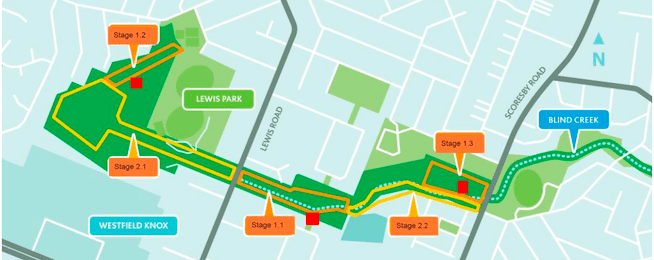A project to rip out a concrete channel and return Blind Creek to a natural waterway will bring 6.3 km of new walking and cycling paths to Wantirna South.
A 1.5 km section of Blind Creek in Lewis Park near the Westfield shopping centre is currently a concrete stormwater drain designed to alleviate flooding.
Melbourne Water, in partnership with the City of Knox, has started a major initiative to replace it with wetlands, paths, bridges and boardwalks.
Melbourne Water says waterway naturalisation can provide many benefits including water quality improvement, ecological restoration, flood mitigation, urban cooling and community recreation and amenity.
A section of Blind Creek from Manuka Drive to Scoresby Road was similarly improved in 2020.
Most of the works will take place away from any shared paths, with access maintained for pedestrians and bike riders at all times.
If shared paths do need to be closed for any reason, details of diversions will be publicised.
The project will be delivered in two stages with Stage1 will beginning the week of Monday 30 January and expected to finish in July 2023. To prepare for works, the project team has already began mobilising in the area.
The site compounds are located at each of the Stage One project areas which include portable offices, toilets and storage for materials.
Access to the work areas will be via Parkhurst Drive with reduced speed signage in place.
The project works include:
- Re-naturalisation of 1.65km of Blind Creek
- Three new wetlands
- Two harvesting ponds
- 6.3km of new paths
- 676,941 plants for improved biodiversity outcomes
- 1,700 new trees for improved shade and cooling
- 65m of boardwalk through the wetland system for improved access and amenity An additional 40,000 cubic meters of flood storage in the retarding basin
- A number of new community infrastructure assets such as community viewing platforms, pedestrian bridges, stepping-stone crossings, benches and tables.
Become our friend
Find out more about Bicycle Network and support us in making it easier for people to ride bikes.
A project to rip out a concrete channel and return Blind Creek to a natural waterway will bring 6.3 km of new walking and cycling paths to Wantirna South.
A 1.5 km section of Blind Creek in Lewis Park near the Westfield shopping centre is currently a concrete stormwater drain designed to alleviate flooding.
Melbourne Water, in partnership with the City of Knox, has started a major initiative to replace it with wetlands, paths, bridges and boardwalks.
Melbourne Water says waterway naturalisation can provide many benefits including water quality improvement, ecological restoration, flood mitigation, urban cooling and community recreation and amenity.
A section of Blind Creek from Manuka Drive to Scoresby Road was similarly improved in 2020.
Most of the works will take place away from any shared paths, with access maintained for pedestrians and bike riders at all times.
If shared paths do need to be closed for any reason, details of diversions will be publicised.
The project will be delivered in two stages with Stage1 will beginning the week of Monday 30 January and expected to finish in July 2023. To prepare for works, the project team has already began mobilising in the area.
The site compounds are located at each of the Stage One project areas which include portable offices, toilets and storage for materials.
Access to the work areas will be via Parkhurst Drive with reduced speed signage in place.
The project works include:
- Re-naturalisation of 1.65km of Blind Creek
- Three new wetlands
- Two harvesting ponds
- 6.3km of new paths
- 676,941 plants for improved biodiversity outcomes
- 1,700 new trees for improved shade and cooling
- 65 m of boardwalk through the wetland system for improved access and amenity
- An additional 40,000 cubic meters of flood storage in the retarding basin
- A number of new community infrastructure assets such as community viewing platforms, pedestrian bridges, stepping-stone crossings, benches and tables.


